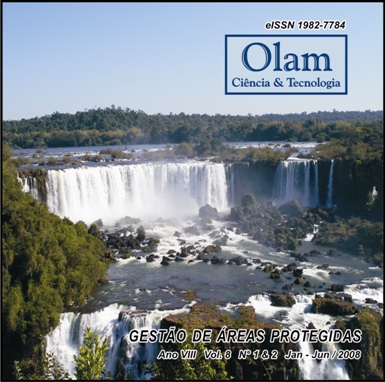CAMINHOS PARA A CONSERVAÇÃO DO PATRIMÔNIO CULTURAL EM UNIDADES DE CONSERVAÇÃO – O CASO DO PARQUE ESTADUAL DA ILHA ANCHIETA
Palavras-chave:
Palavras-chave, Patrimônio Cultural. Áreas Histórico-Culturais. Vestígios Arqueológicos e Arquitetônicos. Unidades de Conservação. Parque Estadual da Ilha Anchieta.Resumo
A Ilha Anchieta deixou de ser uma ilha-presídio e permaneceu por mais de 20 anos sem um uso definido. A transformação da Ilha Anchieta em unidade de conservação de proteção integral, em 1977, ganhou um novo significado e, com ele novas funções. Este trabalho tem por objetivo identificar os vestígios arqueológicos e arquitetônicos das “Áreas Histórico-Culturais” existentes no Parque Estadual da Ilha Anchieta (PEIA), que atribuam ao lugar novos significados e novas formas para compreensão do passado. A coleta de informações envolveu o levantamento cartográfico, iconográfico e documental, através de revisão bibliográfica, consultas às instituições de pesquisa e acervos históricos, observações em campo e testemunho oral de antigos moradores da Ilha. Os resultados indicaram que a maior parte dos levantamentos históricos da Ilha Anchieta se concentra no período que abarca a segunda metade do século XIX e o século XX, tendo em vista a grande importância sociopolítica da implantação do complexo presidiário. Os vestígios da cultura material encontrada em campo indicaram como proposta a implantação de uma trilha histórico-arqueológica, que compreende o espaço formado por um conjunto representativo do funcionamento do complexo carcerário, aliado a uma paisagem natural com pontos de grande beleza cênica. Ainda, este estudo propõe alguns critérios básicos para a inserção dos sítios histórico-arqueológicos do PEIA, em um sistema de visitação controlada, o chamado Turismo Cultural. Palavras-chave: Patrimônio Cultural. Áreas Histórico-culturais. Vestígios Arqueológicos e Arquitetônicos. Unidades de Conservação. Parque Estadual da Ilha Anchieta. Abstract For 20 years without a defined usage, Anchieta Island, a historic and cultural ground (early known as a prison island) was transferred in 1977 to a protection unit giving a whole new meaning and appealing new functions to its existence. This Project have an objective to identify the arqueological and architectural remains from the ‘Cultural-Historic Areas’ present at the State Park of Anchieta Island (PEIA) giving new meaning and new ways to comprehend its past, and its majestic virgin beauty. The collection of information involved a series of cartographic, iconographic mapping through bibliographic revision, institutional research information, historic records, field observation and testimonies from early residents of the Island. Results indicates that most part of the Island’s historic knowledge-base dates back to somewhere between the 19th and 20th century bringing to light a broader view behind the social-politics shown towards the existence of the prison’s complex on the Island. The cultural vestiges found on the Field suggests an implantation of an arqueologic-historical trail with passages through the old imprisonment complex and natural scenic with breathtaking points of beauty. The insertion of a historical-arqueologic 'PEIA' farm-unit on the island requires some basic criteria to deal with and worth mentioning an in/out visitors controlled system named ‘Cultural Tourism’. Key words: Cultural Heritage. Historical Cultural Areas. Archaeologic and Architectonic Vestiges. Conservation Unit. Anchieta Island State Park. OLAM - Ciência & Tecnologia, Rio Claro, SP, Brasil – eISSN: 1982-7784 está licenciada sob Licença Creative Commons. Rio Claro / SP, Brasil Ano VIII Vol. 8 No.2, Janeiro - Junho / 2008 – RESUMOSDownloads
Publicado
17-08-2008
Como Citar
ROBIM, M. de J., VILAR, D. D., FONSECA, F. P., & COCCO, M. D. A. (2008). CAMINHOS PARA A CONSERVAÇÃO DO PATRIMÔNIO CULTURAL EM UNIDADES DE CONSERVAÇÃO – O CASO DO PARQUE ESTADUAL DA ILHA ANCHIETA. OLAM: Ciência & Tecnologia, 8(2). Recuperado de https://www.periodicos.rc.biblioteca.unesp.br/index.php/olam/article/view/1258
Edição
Seção
ARTIGOS







